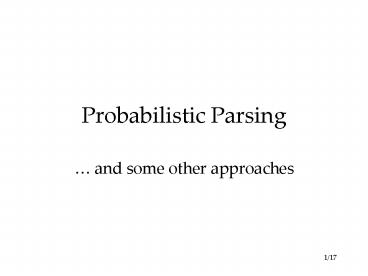Probabilistic Parsing PowerPoint PPT Presentation
Title: Probabilistic Parsing
1
Probabilistic Parsing
- and some other approaches
2
Probabilistic CFGs
- also known as Stochastic Grammars
- Date back to Booth (1969)
- Have grown in popularity with the growth of
Corpus Linguistics
3
Probabilistic CFGs
- Essentially same as ordinary CFGS except that
each rule has associated with it a probability
S ? NP VP .80 S ? aux NP VP .15 S ? VP
.05 NP ? det n .20 NP ? det adj n
.35 NP ? n .20 NP ? adj n
.15 NP ? pro .10
- Notice that P for each set of rules sums to 1
4
Probabilistic CFGs
- Probabilities are used to calculate the
probability of a given derivation - Defined as the product of the Ps of the rules
used in the derivation - Can be used to choose between competing
derivations - As the parse progresses (so, can determine which
rules to try first) as an efficiency measure - Or at the end, as a way of disambuiguating, or
expressing confidence in the results
5
Where do the probabilities come from?
- Use a corpus of already parsed sentences a
treebank - Best known example is the Penn Treebank
- Marcus et al. 1993
- Available from Linguistic Data Consortium
- Based on Brown corpus 1m words of Wall Street
Journal Switchboard corpus - Count all occurrences of each rule variation
(e.g. NP) and divide by total number of NP rules - Very laborious, so of course is done automatically
6
Where do the probabilities come from?
- Create your own treebank
- Easy if all sentences are unambiguous just count
the (successful) rule applications - When there are ambiguities, rules which
contribute to the ambiguity have to be counted
separately and weighted
7
Where do the probabilities come from?
- Learn them as you go along
- Again, assumes some way of identifying the
correct parse in case of ambiguity - Each time a rule is successfully used, its
probability is adjusted - You have to start with some estimated
probabilities, e.g. all equal - Does need human intervention, otherwise rules
become self-fulfilling prophecies
8
Problems with PCFGs
- PCFGs assume that all rules are essentially
independent - But, e.g. in English NP ? pro more likely when in
subject position - Difficult to incorporate lexical information
- Pre-terminal rules can inherit important
information from words which help to make choices
higher up the parse, e.g. lexical choice can help
determine PP attachment
9
Probabilistic Lexicalised CFGs
- One solution is to identify in each rule that one
of the elements on the RHS (daughter) is more
important the head - This is quite intuitive, e.g. the n in an NP
rule, though often controversial (from linguistic
point of view) - Head must be a lexical item
- Head value is percolated up the parse tree
- Added advantage is that PS tree has the feel of a
dependency tree
10
(No Transcript)
11
Dependency Parsing
- Not much different from PSG parsing
- Grammar rules still need to be stated as A? B
c - except that one daughter is identified as the
head, e.g. A ? x h y - As structure is built, the trees are headed by
h rather than A
12
Dependency grammar
- Interest postdates PSG in CL circles
- But dependency approach predates PSG
- Tesnière, Helbig Schenkel, Panini, ancient
Greece
13
Some dependency formalisms
- Constraint grammar (Karlsson)
- Slot Grammar (McCord)
- Link Grammars (Sleator Temperley)
- no name (Järvinen Tapanainen)
14
Categorial grammars
- Ironically named, because they do away with
traditional categories - Lexicon contains syntactic and semantic
information - No grammar as such, just combinatory rules
- Categories are of two types functors and
arguments
15
Functors and arguments
- Arguments have simple categories (taken from a
small set of possible categories) - Functors are expressed as combinations of
arguments - Two operators X/Y and X\Y express possibility of
combination
16
Combination operators
- X/Y is something which combines with a Y to its
right to form an X - e.g. a determiner is an NP/N
- a transitive verb is a VP/NP
- X\Y is something which combines with a Y to its
left to form an X - These can be combined
- e.g. a ditransitive verb as a (VP/NP)/NP
- a VP is an S\NP
- Parsing consists of applying combination rules,
e.g. X/Y Y X
17
Conclusion
- Basic parsing approaches (without constraints)
not practical in real applications - Whatever approach taken, bear in mind that the
lexicon is the real bottleneck - Theres a real trade-off between coverage and
efficiency, so its a good idea to sacrifice
broad coverage (e.g. domain-specific parsers,
controlled language), or use a scheme that
minimizes the disadvantages (e.g. probabilistic
parsing)

